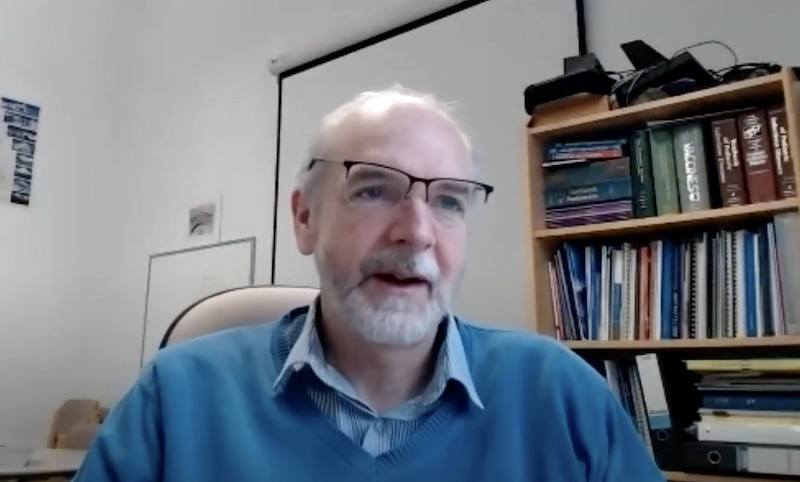Member? Please login
The story behind the Oxford vaccine

Written by Sanae Samata
April 23, 2021
Past Event Round Ups
On April 7, British Chamber of Commerce in Japan members heard from Professor Andrew Pollard, director of the Oxford Vaccine Group, a vaccine research group within the Department of Paediatrics at the University of Oxford.
As chief investigator of the global trials of the Oxford-AstraZeneca vaccine for COVID-19, Pollard shared the story behind the vaccine and answered questions from attendees.
Vaccine development
The team at the University of Oxford began working on the vaccine following receipt of the novel coronavirus’ genetic code, in January 2020. Their efforts focused on the spike protein, the part of the virus that binds to the cell receptor ACE2 in airways to gain entry into the system and cause infection.
Fortunately, he said, the team was able to build on research carried out over the past 20 years on other viruses in the coronavirus family including SARS, which in 2002 killed 11% of those infected, and MERS, which in 2012 killed one third of those infected.
“If the pandemic had not been caused by a coronavirus, we would not be here today with a vaccine to control the pandemic,” he said, pointing to the fact that a vaccine for the virus that causes HIV has not yet been found.
The Oxford-AstraZeneca vaccine is a viral vector variety, made from a weakened version of an adenovirus, or common cold virus. It contains the genetic sequence of the coronavirus’ surface spike protein. When the vaccine enters the body, it uses this genetic code to produce the surface spike protein, inducing an immune response and priming the immune system to attack the coronavirus if it infects the body.
In December 2020, less than 12 months after the vaccine development process began, the Oxford-AstraZeneca vaccine was approved for use in the UK. Producing a vaccine at such speed was a tremendous feat, according to Pollard.
“At the beginning of last year we faced a fairly daunting task. The normal development timeline for a vaccine is 5–15 years,” he said, noting the occurrence of long pauses to secure funding and large-scale manufacturing. “We had to find ways of speeding up these processes.”
The eight-month timespan from placing the first dose into a vial to securing approval “reflects the incredible efforts” of everyone involved, he added.
Very large-scale trials were carried out as part of phase 3 of the vaccine’s development. They included 19 sites in the UK, seven sites in South Africa and six sites in Brazil, as well as sites in the United States, Russia and Japan in partnership with AstraZeneca plc. A further trial was carried out in India under a separate partnership.
By the end of November 2020, the Oxford team had trialled 24,000 volunteers, collected 100,000 blood samples and gathered 500,000 pages of data. Among the trial group there had been no hospitalisations, no severe cases and no deaths. The study showed high vaccine efficacy from the first dose in all age groups of adults.
Furthermore, there was evidence that people could gain “immense protection from the first dose” amounting to 76% efficacy, he said. This was an “important finding” as it shows even in the face of a shortage, administrating first doses provides good protection.
Vaccine roll out
The university’s partnership with AstraZeneca to mass produce the vaccine has been instrumental in helping realize the university’s mission of developing a not-for-profit vaccine, he said. The firm aims to manufacture 3bn doses at some 20 facilities globally, thereby helping to ensure broad, equitable access to the vaccine worldwide.
“We want to get the vaccine to those who most need it,” he added, pointing to the need to defend against vaccine nationalism and restrictions on the movement of vaccines.
So far in 2021, new manufacturing sites have been approved in India and South Korea, which Pollard said would be critical in delivering the vaccine to low- and middle-income countries.
This year has also seen the first doses of the vaccine distributed via COVID-19 Vaccines Global Access (COVAX), an initiative aimed at equitable access to COVID-19 vaccines led by UNICEF, the World Health Organization and others.
Q&A
Moderator Alison Beale, director of the University of Oxford Japan Office, communicated numerous questions from attendees.
Pollard encouraged everyone to get the vaccine, regardless of whether they have had COVID-19, as per UK recommendations.
“The virus is not going to disappear. It’s going to be with us for years,” he said. “It’s essential that we’re vaccinated. The virus will find all of us eventually as it’s incredibly good at transmitting to people.”
Moreover, people need to be vaccinated not only for themselves, but for others. Hospitalizations for COVID-19 prevent people from accessing hospital care, and the disruption to health systems caused by the pandemic is resulting in fewer children being immunized against childhood diseases.
“Measles deaths [among children] are up substantially in the past year. Children are relatively unaffected by the coronavirus but the consequences of the coronavirus have impacted their health,” he said.
Pollard also commented that although vaccination dramatically cuts the risk of severe illness and death, it doesn’t offer complete protection against infection. There is still the possibility of transmitting the virus so people should continue to wear masks and practice social distancing even once vaccinated. He noted the existence of “good evidence” that immunity following vaccination would last beyond six months, but admitted it might be too early to be sure.
On vaccine response according to ethnicity, Pollard said there is “no reason to think the vaccine would perform differently in different populations” as the study showed “identical immunity response in different ethnicities.”
When asked how society could prepare for a future pandemic, he noted the “enormous amount of work to do” based on lessons from the current pandemic. The industry needs to understand and think about the viruses and bacteria that could cause a pandemic and continue to research how vaccines could be developed for them, he said.







